

There’s SO many awesome mushrooms out there to learn to grow – so where do you start? We thought it’s high time we shared our 10 Best Mushrooms to Grow at Home, for beginners.
Ok so by ‘best’ I mean ‘favourite’, I guess. But we’ve also selected these ten species because they are all easy to get started with as a beginner grower, compared to some other wonderful but trickier-to-grow mushrooms.
Easy doesn’t mean boring, though! In the knowledge below you’ll meet some of the most delicious, medicinal and beautiful mushrooms on the planet. This article will give you a rundown of 10 different species that you can learn to cultivate with one or more basic methods, at home, using low-waste techniques (plastic bags begone!).
And firstly – a note – this is all about growing mushrooms from scratch, at home. It’s not about mushroom fruiting kits. While kits look great when they’re fruiting on your bench, they’re not a very economical (or environmentally friendly) way to grow more than a handful of mushrooms at home. But they can make your heart skip with how cool fruiting mushrooms are, so that’s a good thing. Anyway – on to the good stuff of actual home mushroom growing…
May we introduce you to…
This article is intended to introduce you cordially to 10 of our favourite edible and medicinal mushroom species, and what they need to grow, if you want to cultivate them at home. From there, you can read on through our resources, and learn the how of it all.
To learn more about the different growing techniques to grow these mushrooms, you can head to our beginner mushroom growing guide, our free mini-course, all our mushroom growing resources, or our short courses.
I must add that we also teach a complete Home Mushroom Cultivation course, but if you’re doing that one, you don’t need this article – because you’ve got access to all this knowledge, and much more, inside your course!
And if you’d like to dig deeper into the kind of fungi we’re talking about here (there’s a whole world of them!), head to our Life Cycle of Fungi rundown.
Lastly, most of these mushrooms can also be grown in jars using sterile culture techniques, but we don’t recommend you start there – get some low-tech beginner skills first, have your mind blown by the world of fungi, then learn more advanced techniques once you’ve got your mushroom growing game on.
Alrighty then – let’s go meet some mushrooms…


Oyster mushroom (Pleurotus ostreatus)
Family: Pleurotaceae. Genus: Pleurotus. Species: ostreatus. Common names: Oyster Mushroom, Tree Oyster, Oyster Shelf, Straw Mushroom, Hiratake, Tamogitake.
Ecology: Saprobic – primary decomposer – this kind of mushroom’s mycelium eats certain kinds of raw organic material, like straw or sawdust
This is by far the easiest mushroom to cultivate. This species includes the different varieties: Pearl, White and Tan oyster to name a few. It is said to originate from North America and Europe, but they grow in hardwood and fir forests all around the world.
Fun fact: Oyster Mushrooms are carnivorous. They can devour any small critter that tries to eat their mycelium, which is why they are such effective myceliators of substrate! Harvest your Oysters before the cap goes from concave to convex, if you leave them too long they’ll start to become brittle, won’t hold their shape while you cook them and smell quite fishy.
Cultivation methods:
On Pasteurized Substrate: in buckets or bags – beginner level. For it’s substrate, this species likes straw / hardwood sawdust / all kinds of agricultural wastes, amended with up to 10% bran.
In Garden Beds: beginner level. Oysters love straw or strawbales.
On Logs: beginner level. This species likes to grow on alder, aspen, beech, birch, elm, maple, oak, poplar, willow.
For indoor (bucket) cultivation, Pleurotus ostreatus likes an incubation temperature of around 24 °C / 75 °F. Incubation takes about 17 days. They fruit best between 10°C / 50 °F and 21°C / 70 °F, and like a humidity of 88%.
Cooking & preserving:
We use these mushrooms for prettymuch everything you can think of – mushroom mince, stirfries, dumplings, mushroom jerky, mushroom pickles and on and on. Meat-free Oyster Mushroom “bone broth” is extra delicious and healing.
More Pleurotus resources:
To learn more about how to grow these from scratch at home, with low waste techniques – head to our beginner guides & resources, plus all our mushroom cultivation articles are here.


Shiitake (Lentinula edodes)
Family: Omphalotaceae. Genus: Lentinula. Species: edodes. Common names: Shiitake, Golden Oak Mushroom
Ecology: Saprobic – primary decomposer
Log cultivation of Shiitake mushrooms in Japan dates back to at least 2000 years. It is a true saprophyte, in other words it only grows on dead wood. Shiitake has antibacterial qualities and is very rich in beta-glucans which are anti-inflammatory. Shiitake is the second most grown mushroom in the world, next to the common button mushroom and is easy and fun to grow on logs.
Cultivation methods:
On Logs: beginner level. This species likes to grow on the wood of oak, beech or chestnut (preferred) but we’ve found they also do well on acacia, alder, ash, eucalyptus (thin barked ones like spotted or manna gum), hickory or liquid amber (sweetgum).
For outdoor cultivation, Lentinula edodes likes a mild and shady spot, with relatively high humidity. You should see signs of fruiting within 12-18 months of log inoculation.
Cooking & preserving:
Shiitake have a very similar texture to fresh porcini mushrooms, and can be used interchangeably in pastas and risottos, dried and preserved. They are perfect for making the Japanese stock dashi.
More shiitake resources:
Here’s a beginners guide, a video article, and a short course on log cultivation which features shiitake growing.

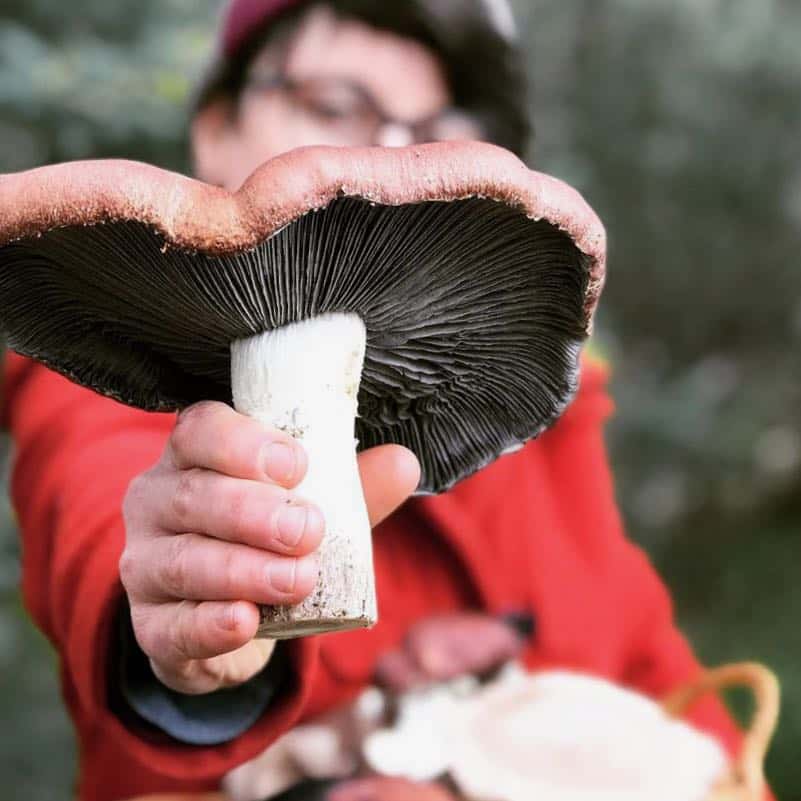
King Stropharia (Stropharia rugosoannulata)
Family: Strophariaceae. Genus: Stropharia. Species: rugosoannulata. Common names: King Stropharia, Garden Giant, Burgundy Mushroom, Wine Caps, Wine Red Stropharia
Ecology: Saprobic (secondary decomposer)
The King Stropharia has a beautiful dark reddish-purple pileus and greenish grey gills. They are easy to grow outdoors in beds of fermented hardwood wood chips or straw inoculated with grain, sawdust or cardboard spawn. Cardboard spawn can be made by placing harvested stem butts in damp cardboard. They can be difficult to cultivate indoors as they prefer a complex microbe-rich substrate.
This fungi thrives in subtropical to cool temperate climates. The mushrooms can grow to be very large, but they’re best picked when they’re young and firm. Can be used to remediate excess nitrogen in chicken runs. S. rugosoannulata mycelium can also kill and trap soil nematodes.
Cultivation methods:
In Gardens: beginner level. This species likes to grow on fermented straw / older hardwood chips / cardboard / leaves. Bacterial rich soil or compost casing layer can help stimulate fruiting.
For outdoor cultivation, Stropharia rugosoannulata has a few particular needs and temperature considerations to grow well, which are outlined in the resources below.
Cooking & preserving:
Harvest when approximately 5-7 cm wide, cut in half (no need to thinly slice) and braise. These mushrooms are really delicious with mustard or red wine sauce. Must be eaten cooked as they can cause digestive upset when eaten raw.
More king stropharia resources:
Here’s a mini workshop we made about garden cultivation, and we also have a short course on garden cultivation, which features King Stropharia


Enokitake harvest with a few shiitakes
Enokitake (Flammulina velutipes)
Family: Physalacriaceae. Genus: Flammulina. Species: velutipes. Common names: Enoki, Velvet Shank
Ecology: Saprobic (primary decomposer)
Wild enokitake looks very different from commercially cultivated enokitake. While the commercial stuff is almost white in colour and clumped together very densely, the wild mushrooms are recognisable through the following traits:
- Reddish-brown to orangish to yellow-brown pileus (cap)
- Cap is Slippery when wet
- Whitish to yellowish gills in a convex form (adnexed hymenium)
- Bare stipe (stem), no remnant of where the cap was attached to the stipe
- Stipe is dark at the base and golden at the top and looks vaguely velvet-like
- Saprotrophic (feeding on decomposing wood)
- White spore print
- Tastes amazing (check this only once you’re satisfied on all above counts)
Enokitake is best cultivated in the garden on logs and stumps and can withstand very cold temperatures (it’s known as the snow mushroom for a reason!).
Cultivation methods:
on Logs: beginner level. Enokitake likes to grow on fresh hardwood logs or stumps. Inoculate above ground – allowing them to colonise for 6 months. Good results can be obtained by using the ‘raft’ method – burying in a layer of fresh hardwood chips. Will fruit in the colder months.
in Gardens: ‘give-it-a-go’ level. We’ve had patchy success transferring a handful of enokitake mycelium to sawdust mulch below various perennials, like currants, and just letting it live it’s best life. It works sometimes!
Cooking & preserving:
Enokitake mushrooms that are grown indoors (with the familiar elongated white appearance) – are commonly eaten fresh – sprinkled over salads, as a garnish, or floated in soups and broths. For the outdoor ones – either cultivated or foraged – they are amazing lightly fried. I’ve also brined them using a lacto-ferment – recipe here – and they were deeelish.
More enokitake resources:
Here’s a beginners guide, a video article, and a shot course on log cultivation which can be used for enokitake. And here’s our article about growing enoki underneath currant bushes.


King Oyster (Pleurotus eryngii)
Family: Pleurotaceae. Genus: Pleurotus. Species: eryngii. Common names: King Oyster, King Trumpet Mushroom, French Horn Mushroom, King Brown Mushroom, Boletus of the Steppes, Trumpet Royale, Seta de Cardo (Spanish)
Ecology: Saprobic (primary decomposer)
King Oyster mushrooms have a convex cap becoming funnel-shaped with big and robust stems. Unlike other Pleurotus spp. they often grow vertically out of the top of their substrate, which why they get a special mention here – they are big! And also very meaty and delicious.
Several new varieties and hybrids of P. eryngii and P. ostreatus (such as Black Pearl King Oyster) have recently become available. King Oysters get their species name – eryngii – due to their habit of growing off the roots and decaying matter of Eryngium spp. of plants such as the beautiful but spikey Sea Holly and Field Eryngo. In the mountains of northern Spain where this mushroom grows wild with these plants, it is also known as Seta de Cardo (arrow of the thistle).
Unlike other oyster mushrooms, P. eryngii can sometimes thrive growing in soil and thus has great potential for bioremediation. King oysters tend to yield better on logs or sawdust rather than in pure straw, but if you can grow some Eryngium spp. on plants you may have better results.
Cultivation methods:
In Buckets / Bags: beginner/intermediate (depending on your climate): King oysters like a 4:1 hardwood sawdust to straw or other agricultural wastes amended with up to 10% bran or cottonseed meal. Use holes in lid of bucket only and leave 5cm / 2″” of space or ‘head room’ in the top of the bucket. Remove the lid when ready to fruit.
In Gardens: beginner/intermediate (depending on your climate): King oysters like mounds of straw / sawdust cased with soil, especially in a garden planted with Eryngium spp. (Sea Holly)
On Logs: beginner/intermediate (depending on your climate): King oyster plus will grow on most hardwoods inc alder, aspen, ash, beech, birch, elm, maple, oak, poplar, willow.
For indoor (bucket) cultivation, Pleurotus eryngii likes an incubation temperature of around 24 °C / 75 °F. Incubation takes about 14 days. They fruit best between 15 °C / 59 °F and 21 °C / 70 °F, and like a humidity of 88%.
Cooking & preserving:
Make the most of the thick stems of these mushrooms by slicing them into thick steaks and frying in butter. The outside becomes gold and crispy while the inside is like soft abalone. Try this recipe – Trumpet Mushroom Scallops with Brown Butter and Thyme.
More king oyster resources:
To learn more about how to grow these from scratch at home, with low waste techniques – head to our beginner guides & resources, plus all our mushroom cultivation articles are here.


Lion’s mane (Hericium erinaceus / coralloides)
Family: Hericiaceae. Genus: Hericium. Species: erinaceus / coralloides. Common names: Lion’s Mane, Monkey’s Head, Sheep’s Head, Old Man’s Beard, Hedgehog Mushroom, Pom Pom, Yamabushitake
Ecology: Saprobic (primary decomposer)
H. erinaceus is very similar to H. coralloides (Coral Tooth Fungi – also sold as Australian Lions’ Mane). This is a stunning fungus, resembling a mane of falling white spikes.
It naturally appears on the wounds of living or very recently cut hardwoods in temperate climates, but it can be grown in jars of sawdust or on logs. The mycelium is weak and wispy and can be hard to distinguish from contamination. It can be tricky to get the mycelium growing and when grown in containers it requires sterile substrates but it is quite easy to fruit even in poor conditions. We’ve had jars produce many flushes even 6 months after inoculation.
The positive effects of this fungi on the brain’s cognitive function have been extensively studied.If cooking, harvest while young and firm for the best texture.
Cultivation methods:
On Logs: beginner/intermediate: Lions Mane likes to grow on logs or stumps, preferably in contact with the earth. Plant logs vertically in sandy soil in shady spots with 1/3 buried. Does well on logs of beech, elm, maple, oak, possibly others including fir. Not alder or birch.
Cooking & preserving:
Lion’s mane has a flavour reminiscent of lobster which makes it perfect for replacing crab in recipes. Absolutely delicious. Also try adding it to pizzas or a miso broth. Try this recipe for lion’s mane ‘crab’ cakes. Lions Mane is also highly medicinal, in lots of ways.
More lions mane resources:
Here’s a beginners guide, a video article, and a shot course on log cultivation which can be used for lions mane. You can also use this simple tincture recipe for lions mane.


Pink Oyster (Pleurotus djamor)
Family: Pleurotaceae. Genus: Pleurotus. Species: djamor. Common names: Pink Oyster, Salmon Oyster, Strawberry Oyster, Flamingo Oyster, Takiiro Hiratake, Tabang Ngungut (Borneo)
Ecology: Saprobic (primary decomposer)
This oyster variety gets a special mention because we love it! Pink oysters form beautiful, vibrantly pink ‘bouquets’ of fruiting bodies. The pink fades as the mushrooms age and as you cook them, but the pink IS preserved when you dry them. The mycelium can be very thin and wispy and can be easily confused with contamination.
Easy to cultivate and incredibly fast to grow in summer or in subtropical climates, making it a good choice for growing on fresh, used coffee grounds as this ‘rich’ substrate often results in contamination with slower growing species.
This fungus loves hot humid days, which makes it a good summer oyster mushroom strain.
Cultivation methods:
On Pasteurized Substrate: in buckets or bags – beginner level. For it’s substrate, this species likes straw or bagasse or hardwood sawdust supplemented w/ up to 10% bran or 20% used fresh coffee grounds.
In Garden Beds: beginner level. Use straw or strawbales
On Logs: beginner level. This species likes to grow on alder, aspen, beech, birch, elm, maple, oak, poplar, willow.
For indoor (bucket) cultivation, Pleurotus djamor likes an incubation temperature of around 27 °C / 81 °F. Incubation takes about 9 days. They fruit best between 20 °C / 68 °F and 30 °C / 86 °F, and like a humidity of 88%.
Cooking & preserving:
Use similarly to Pleurotus ostreatus. Unfortunately the delightful pink colour of these mushrooms cooks out. But as said, the colour is retained when dried. Great candidate for jerky or mushroom ‘bacon’ recipes.
More pink oyster resources:
To learn more about how to grow these from scratch at home, with low waste techniques – head to our beginner guides & resources, plus all our mushroom cultivation articles are here.

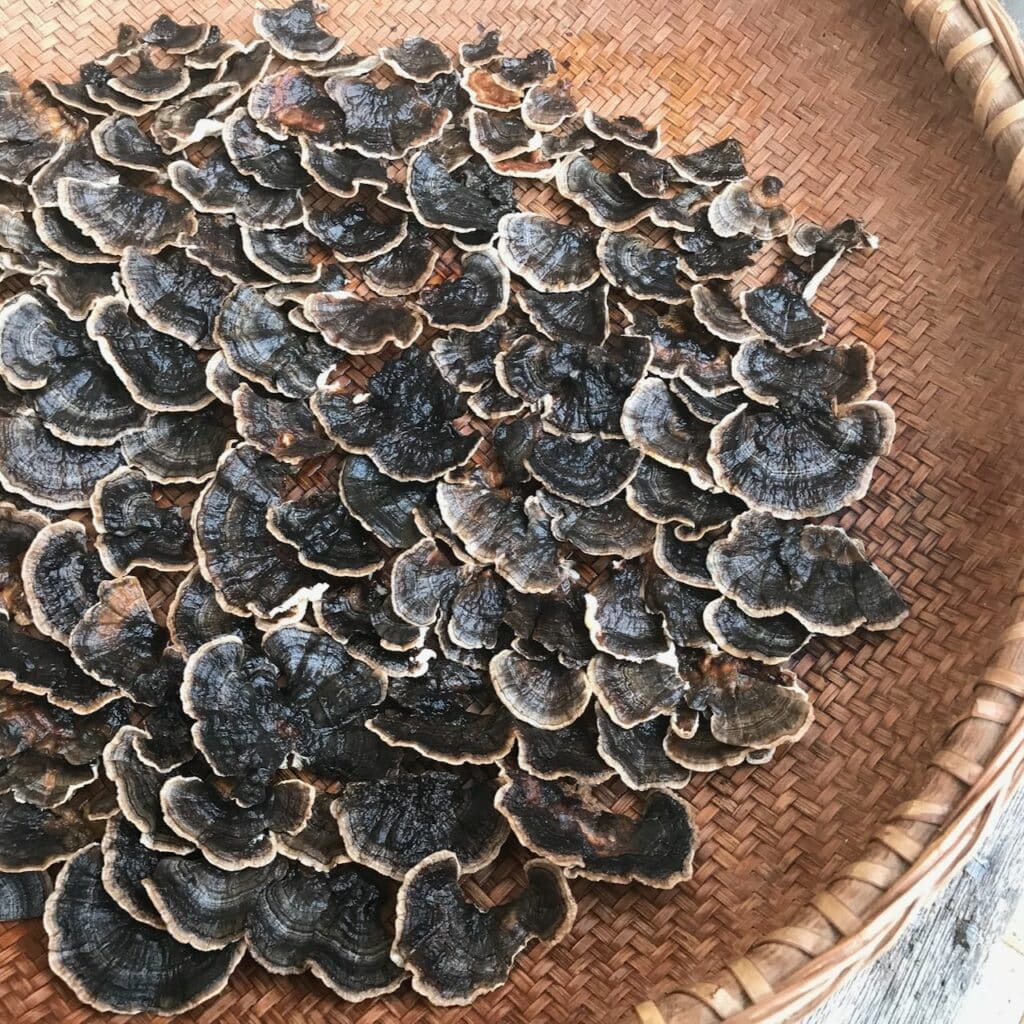
Turkey Tail (Trametes / Coriolus versicolor)
Family: Polyporaceae. Genus: Trametes / Coriolus. Species: versicolor. Common names: Turkey Tail, Many Coloured Polypore, Kawaratake, Yun Zhi, Cloud Mushroom
Ecology: Saprobic (primary decomposer)
Known as either Coriolus versicolor, Trames versicolor or Turkey Tails, these are small bracket fungi with fuzzy caps featuring defined bands of different colours, including various shades of cream, grey, yellow, orange and brown resembling… wait for it.. a turkey tail. The cap is thin and flexible and the whitish brown underside is covered with small pores.
Trametes species are common all over the world so they are easy to find when foraging (see link below) and often grow on your logs when you are trying to grow something else like Shiitake. T. versicolor can be difficult to distinguish from many of its close relatives but there are supposedly no poisonous Trametes species. Be careful of similar-looking Stereum spp and others.
Trametes versicolor is used in traditional Chinese medicine as a tonic, and studies suggest that it has immunostimulant and antitumor properties. Polysaccharide-K (PSK), a proprietary product derived from Trametes, was developed for cancer treatment in Japan. Trametes can be grown sawdust or even more easily on logs.
Cultivation methods
On Pasteurized Substrate: in buckets or bags – beginner/intermediate. For it’s substrate, this species likes hardwood sawdust / wood chips supplemented with up to 5% bran.
On Logs: beginner/intermediate: Turkey Tail likes to grow on logs laid on the ground or stumps, preferably in contact with the earth. Plant logs vertically in sandy soil with 1/3 buried or in plastic pots covered with hardwood sawdust, then sand. Does well on logs of alder, aspen, eucalyptus, elm, oak, poplar, just about any hardwood.
Cooking & preserving:
Best consumed steeped in hot water as a tea, added when making a stock (simmer for at least 2 hours) or as a tincture.
More turkey tail resources:
See our article on Foraging and Using Turkey Tail Mushrooms – including basic tincture recipe, also this great article on identifying true Turkey Tails. And here’s an in-point to the land of research on turkey tails health benefits.
Here’s a beginners guide, a video article, and a shot course on log cultivation which can be used for turkey tails.

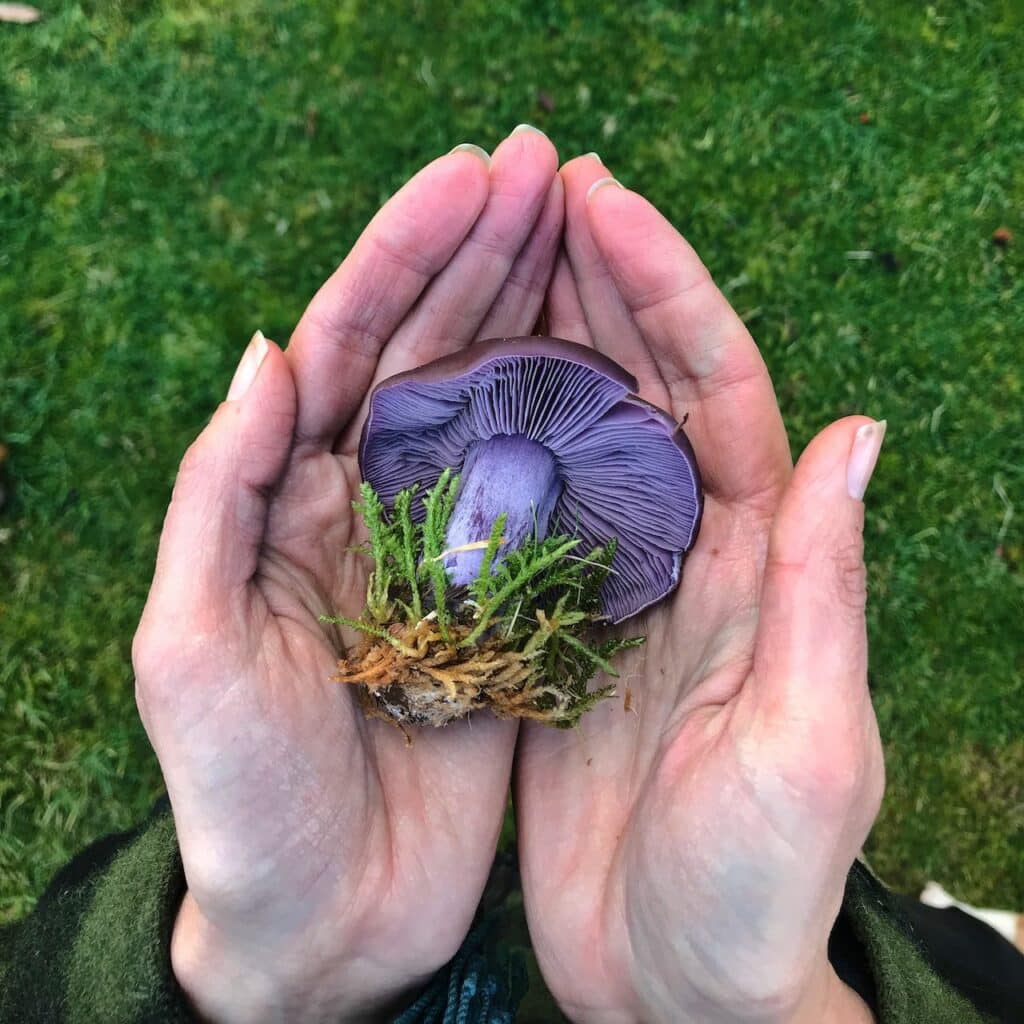
Wood blewit (Clitocybe / Lepista nuda)
Family: Tricholomataceae. Genus: Clitocybe / Lepista. Species: nuda. Common names: Wood Blewit
Ecology: Saprobic (secondary decomposer)
A stunning mushroom with vibrant lilac coloured gills and stipe while it’s young, with a tan coloured cap. The purple colouring fades with maturity and with cooking. The mycelium is wispy with a lovely blue/lilac colour too, while the spores are blush or dusty pink.
Native to Europe and North America, but naturalised in many parts of the world (including Australia), wood blewits fruit in late autumn to early spring in woodland areas, in temperate climates. They are a perfect candidate for growing in mushroom gardens. Blewits thrive on a complex substrate of multiple organic materials, including partially decomposed yard waste, twigs, leaves, grass clippings, bark, hay, pine needles, and compost.
Look for a shady area in your yard to cultivate these, where you’ll have easy access to water, and the bed is protected from the elements. We’ve also had great success establishing blewits by adding stem butts from wild specimens to maturing compost and then using the resulting myceliated compost to establish beds in the garden.
Build beds in the autumn/fall or spring, when it is as cool as possible but with low risk of frost and keep moist all year. Garden beds will likely take a year to fully myceliate and fruit. This species is not suitable for tropical climates.
Cultivation methods
In Garden Beds: beginner level. This species grows well on ermented straw / older hardwood chips / cardboard / leaves w/ bacterial rich soil or compost.
Cooking & preserving:
These mushrooms have a lightly citrusy smell, and hold their shape when cooked. They are one of those mushrooms that MUST only be consumed well-cooked, to break down tummy-upsetting compounds. Pairs well with sage. Try this Pan Roasted Blewits with Sage, or this Wood Blewit and Spaghetti Squash Gratin.
More wood blewit resources:
Here’s a mini workshop we made about garden cultivation, and we also have a short course on garden cultivation, which can be used for wood blewits. Here’s some more great tips for growing wood blewits from the folks at Field & Forest.
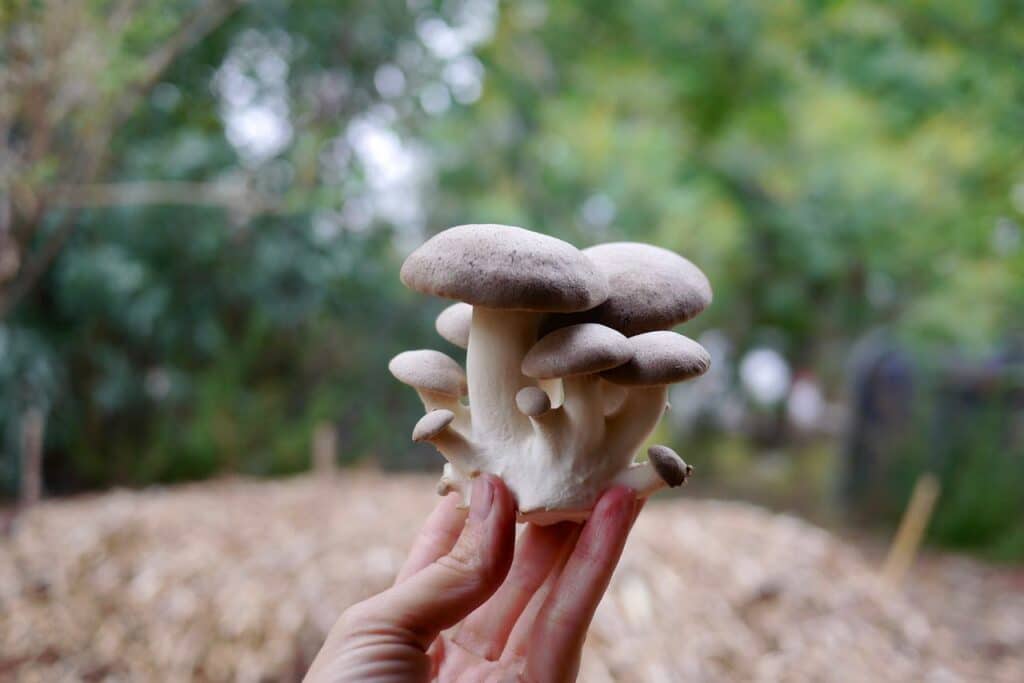
Extra resources:
Read and watched all our free mushroom guides, courses and resources? Here’s a few more things for you:
- The Milkwood spawn list – places we recommend to get spawn from around the world – verified by us and/or our students across the globe.
If you have any questions about any of the species above – comment below, and we can help. Best of luck choosing what to grow first!



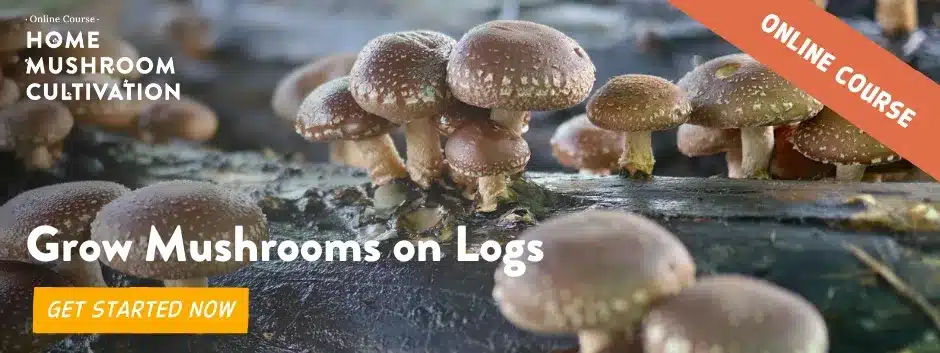









Awesome and thank you
You’re welcome 🙂
Well written. Lots of my favourites.
Great!
Hi. I want to start growing mushrooms at home but I want to make it as sustainable as possible so that I don’t have to keep buying spawn. Do you buy spawn – or keep producing more spawn from the one you initially bought – or do you buy liquid culture and make your own spawn.
Hiya – we do both, depending on whats happening at ours – buy spawn, and also make our own liquid culture from other mushrooms 🙂